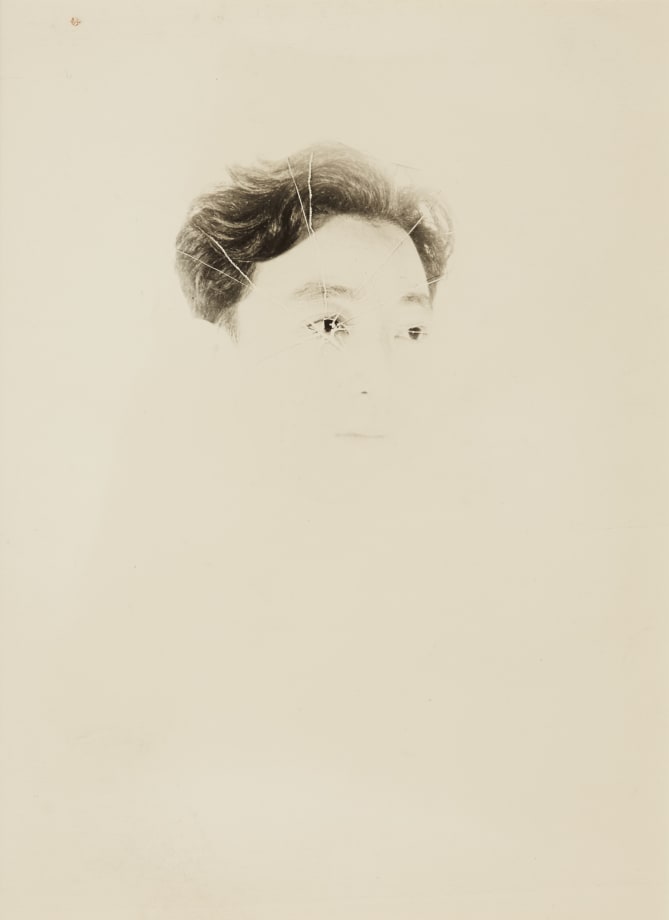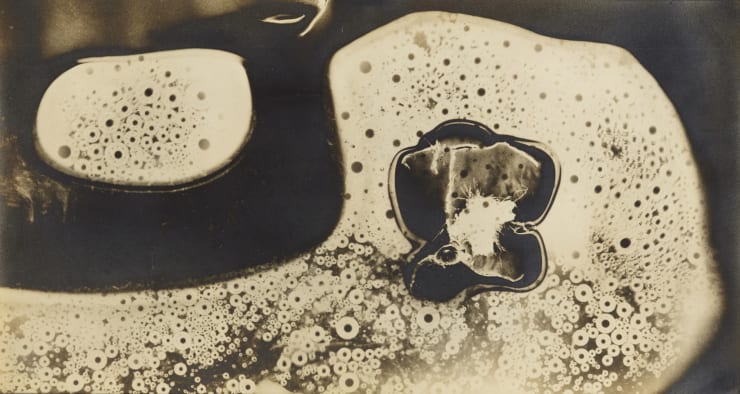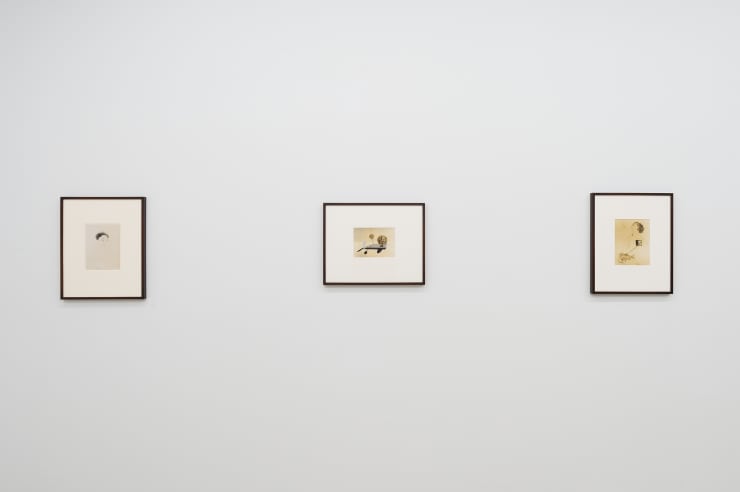Kansuke Yamamoto
Nonaka-Hill is pleased to present a solo exhibition of works by Kansuke Yamamoto from September 22 to November 10, 2018.
Kansuke Yamamoto, a Surrealist poet and photographer, was born in Nagoya in 1914 and died there in 1987. Yamamoto’s father, Goro Yamamoto, was a photographer working in the Pictorialist style and owner of Nagoya’s first photography supply store. In this environment, Yamamoto naturally absorbed the mechanics of photography, but was initially ambivalent about the medium. He began to write poetry in 1930, and entered Tokyo’s Meiji University in the French Literature Department where he was exposed to the latest Western art movements and theories, such as Surrealism, Dadaism, Bauhaus, Neue Sachlichkeit. Attracted to Surrealism, a movement concerned with the unconscious, chance, and unexpected juxtapositions, Yamamoto returned return to Nagoya in 1931 and began, at age of 17, to “practice Surrealism in photography”. He used a variety of methods, including collage and photomontage. The fourteen vintage photographic works on view were produced by Yamamoto between 1935 and 1968, and demonstrate Yamamoto’s Surrealist inflections into landscape, still-life, figuration, self-portraiture, narratives and abstraction, distinctively merged with Japanese aesthetic characteristics.
Yamamoto’s poetic sensibility also embraced a sharp eye for social criticism, responding to the times in which he lived. The Taisho Era, which had embraced foreign influence, lifestyle choices and free-thought ended in 1926 when Yamamoto was only 12 years old. The following Showa Era, which lasted for the rest of Yamamoto’s life, was militaristic and aggressively suspicious of foreign influences, especially Communism (which was known to be linked to the European Surrealists). In Yamamoto’s case, the 1937 exhibition “Kaigai Chogenjitsushugi Sakuhinten” (Exhibition of Overseas Surrealist Works) inspired him to publish the Surrealist poetry journal Yoru no Funsui (“The Night’s Fountain”), but Yamamoto was forced to cease publication after the fourth volume due to censorship from the “Thought Police” (formally: Special Higher Police / Tokubetsu Koto Keisatsu). Avant-garde thought was under-attack. Some artists were jailed, while others lived in fear. Yamamoto and his colleagues continued to operate carefully and quietly “under the radar” through the wartime years with a strong sense of community. Yamamoto was a key member of several artist and poet groups including VIVI (which he founded) and with the avant-garde poets’ group VOU, organized by Katsue Kitasono, where Yamamoto contributed poetry and visual works to the group’s journal and “Keisho” exhibitions until 1978, when VOU dissolved.
Yamamoto, by his nature, was never self-promoting – not even when he corresponded with French Surrealists to publish their works. He lived through oppressed times, but continued to work with commitment to Surrealism while other photographic trends formed in Japan and became historicized. A 2001 solo exhibition at Tokyo Station Gallery, co-curated by John Solt and Ryuichi Kaneko brought a new audience to Yamamoto’s lifelong work.
Nonaka-Hill’s exhibition marks a return of Yamamoto’s work to Los Angeles after two museum exhibitions in 2013. It was subject of a two-artist exhibition at J. Paul Getty Museum entitled: “Japan’s Modern Divide: The Photographs of Hiroshi Hamaya and Kansuke Yamamoto”(1), and was featured in LACMA’s exhibition “Drawing Surrealism” (2).
Yamamoto’s work is included in the collections of the Nagoya City Art Museum, Tokyo Photographic Art Museum, Santa Barbara Museum of Art, the J. Paul Getty Museum, The Art institute of Chicago, and others.
(1) curated by Judith Keller and Amanda Maddox
(2) curated by Leslie Jones
-
 Kansuke YamamotoI’d Like to Think While Inside the Body of A Horse, 1964Gelatin silver printImage and paper:
Kansuke YamamotoI’d Like to Think While Inside the Body of A Horse, 1964Gelatin silver printImage and paper:
9 x 7-3/8 inch
22.8 x 18.7 cm -
 Kansuke YamamotoSelf-Portrait, 1949Gelatin silver printImage and paper:
Kansuke YamamotoSelf-Portrait, 1949Gelatin silver printImage and paper:
9-1/8 x 6-13/16 inch
23.1 x 17.3 cm -
 Kansuke YamamotoTitle unknown, ca. 1935Gelatin silver printImage & paper size:
Kansuke YamamotoTitle unknown, ca. 1935Gelatin silver printImage & paper size:
9-3/16 x 11-13/16 inch
23.3 x 30 cm -
 Kansuke YamamotoMy Thin-aired Room, 1956Gelatin silver printImage size: 9-11/16 x 10-1/2 in, 24.7 x 26.5 cm
Kansuke YamamotoMy Thin-aired Room, 1956Gelatin silver printImage size: 9-11/16 x 10-1/2 in, 24.7 x 26.5 cm
Paper size: 10 x 10-3/4 in, 25.3 x 27.1 cm -
 Kansuke YamamotoMy Thin-aired Room, 1956Gelatin silver printImage size: 9-11/16 x 10-1/2 in, 24.6 x 26.7 cm
Kansuke YamamotoMy Thin-aired Room, 1956Gelatin silver printImage size: 9-11/16 x 10-1/2 in, 24.6 x 26.7 cm
Paper size: 10 x 10-3/4 in, 25.3 x 27.3 cm -
 Kansuke YamamotoWork, 1956Gelatin silver printImage and paper size:
Kansuke YamamotoWork, 1956Gelatin silver printImage and paper size:
6-3/16 x 11-7/16 inch
15.7 x 29.1 cm -
 Kansuke YamamotoWork, 1958Gelatin silver printImage and paper size:
Kansuke YamamotoWork, 1958Gelatin silver printImage and paper size:
16-5/16 x 10-3/8 inch
41.4 x 26.3 cm -
 Kansuke YamamotoHeart in Motion - Shadow of Happiness, 1950Gelatin silver printImage size: 9 3/4 x 7 1/2 in
Kansuke YamamotoHeart in Motion - Shadow of Happiness, 1950Gelatin silver printImage size: 9 3/4 x 7 1/2 in
Paper size: 10 1/8 x 7 3/4 in
Image size: 24.7 x 19.2 cm
Paper size: 25.6 x 19.7 cm -
 Kansuke YamamotoFloating City, 1950Collage on gelatin silver print, paperImage size: 6 1/8 x 8 3/4 in
Kansuke YamamotoFloating City, 1950Collage on gelatin silver print, paperImage size: 6 1/8 x 8 3/4 in
Paper size: 6 3/4 x 9 1/8 in
Image size: 15.7 x 22.3 cm
Paper size: 17 x 23 cm -
 Kansuke YamamotoWork, 1959Gelatin silver printImage & paper size: 7-1/4 x 9-11/16 in, 18.5 x 24.9 cm
Kansuke YamamotoWork, 1959Gelatin silver printImage & paper size: 7-1/4 x 9-11/16 in, 18.5 x 24.9 cm -
 Kansuke YamamotoTitle unknown, 1950Gelatin silver printImage & paper size: 9 5/8 x 11 3/4 in
Kansuke YamamotoTitle unknown, 1950Gelatin silver printImage & paper size: 9 5/8 x 11 3/4 in
Image & paper size: 24.4 x 29.9 cm -
 Kansuke YamamotoWork, 1959Gelatin silver printImage size: 6-7/8 x 7 in, 17.5 x 17.7 cm
Kansuke YamamotoWork, 1959Gelatin silver printImage size: 6-7/8 x 7 in, 17.5 x 17.7 cm
Paper size: 8 x 7-5/8 in, 20.4 x 19.3 cm -
 Kansuke Yamamotooh Agatha, 1969Gelatin silver prints mounted on wooden panelImage size: 2 3/4 x 4 1/8 in each
Kansuke Yamamotooh Agatha, 1969Gelatin silver prints mounted on wooden panelImage size: 2 3/4 x 4 1/8 in each
Panel size: 20 x 23 7/8 x 1 in
Image size: 7 x 10.5 cm each
Panel size: 50.8 x 60.6 x 2.5 cm -
 Kansuke YamamotoWork, 1959Gelatin silver printImage & paper size: 11-1/2 x 7-13/16 in, 29.2 x 19.9 cm
Kansuke YamamotoWork, 1959Gelatin silver printImage & paper size: 11-1/2 x 7-13/16 in, 29.2 x 19.9 cm -
 Kansuke YamamotoButterfly, 1970Gelatin silver printImage size: 6-5/16 x 4-1/2 in, 16.1 x 11.5 cm
Kansuke YamamotoButterfly, 1970Gelatin silver printImage size: 6-5/16 x 4-1/2 in, 16.1 x 11.5 cm
Paper size: 12 x 10-1/8 in, 30.5 x 25.7 cm





























